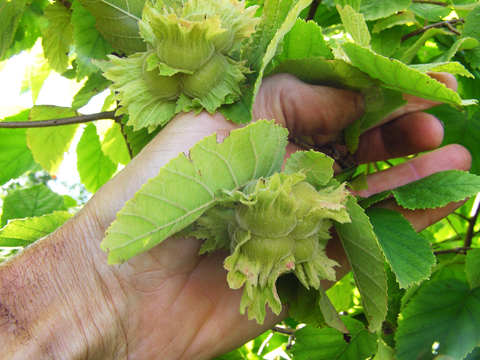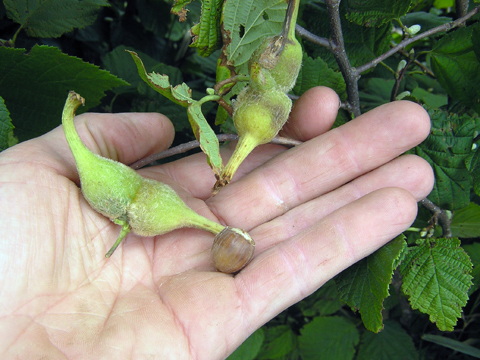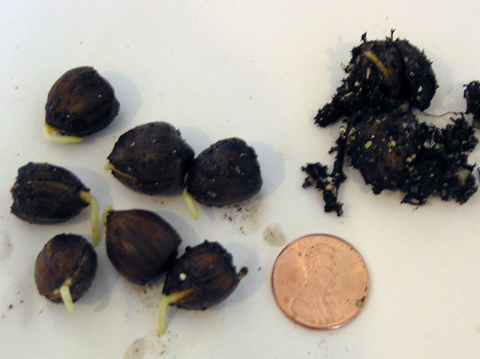 |
| Home | Ordering By Mail | Purchase Manual: Using Native Plants in Urban Landscapes |
|
|||||
Species Name: Corylus americana
Corylus cornuta
Common Name: American hazelnut
Beaked hazelnut
Zone: 4 to 9
Distribution: Southern Maine in the north, south to Georgia and Texas
Seed collection: Collect seed in early September into October in western New York. Harvest nuts early before local wildlife discovers them and consumes every last nut. At maturity the husk covering the nuts begins to turn yellow and then gradually turns a dry brown. The nut will begin to dry and shrink loosening the nut from the husk. The nuts will naturally fall to the ground if the nuts are not harvested or consumed by wildlife. Protect nuts at all times from squirrels and mice. Do not underestimate the determination of rodents to eat hazelnuts.
Seed handling: Nuts can be collected with the husk still attached or harvest just the nut if the nuts separate from their husk. Beaked hazelnut typically is collected with the husk attached. Nuts can be stored dry for several weeks after harvest with little loss of viability. Dry storage for prolong periods will desiccate the nut and eventually the embryo will die.
Remove the nuts from their husk for storage and planting. If allowed to dry for a period of time the nuts will naturally shrink and loosen from the husk for easy removal. The nuts can also be removed from the husk by crushing and rolling them with your foot over a screen or rough surface or by hand shelling.
A percentage of nuts will be unsound and have no viable embryo. A float test will separate unsound nuts from sound. Sound seeds will sink to the bottom while unsound seeds will float. Any nuts that are firmly attached to the husk after drying are most likely unviable. This is a reliable indicator. You can confirm viability by cracking several nuts to verify that they have no embryo.
Stratify nuts by placing in moist potting mix for prolonged storage until ready to plant in the spring or plant immediately in the fall. Stratified seed cannot be stored for longer than one growing season.
Germination requirements: Nuts only require a chilling period of 1 to 2 months to overcome dormancy. Exposing nuts to natural outdoor temperatures is the easiest way to satisfy the chilling requirement. The majority of nuts will germinate the first spring if planted in the fall or cold stratified over the winter. Sow nuts ½ to 1” deep in prepared beds, in individual pots or in the ground. Fall planting results in good germination.
Ecology: Beaked and American hazelnut have significant ecological value and should be widely planted. The nuts are easy to harvest and are easy to grow from seed.
Both hazelnuts (AH) (BH) grow in full sun to fairly dense shade. Hazelnuts produce far more nuts when grown in full sun so planting along the forest edge, in hedgerows and old fields will encourage increased nut production. They also provide valuable cover, nesting habitat and foraging sites for birds. Where BH grows in the forest understory it often is a significant component of the understory shrub community.
The nuts provide an important fall food source for many animal species, the twigs and leaves are browsed by deer and the winter buds, young leaves and catkins are eaten by turkey, grouse and other birds. Numerous species feed on hazelnuts including bear, deer, turkey, grouse, Blue jays, woodpeckers, squirrels, chipmunks and mice.
Blue jays are the primary dispersal agent for hazel nuts. The nuts are the perfect size for jays to transport and jays cache nuts in the ground for future retrieval during the winter. All other animals that feed on hazel nuts with the exception of squirrels, that also cache nuts, consume the nuts and do not contribute to reproduction. Nuts that remain uneaten after caching will readily germinate and grow. Hazel nuts also spread vegetatively by suckering from their roots. Plants’ growing in shade spread primarily by suckering as nut production in shade is usually quite low.

American hazelnuts

Beaked hazelnuts

Beaked hazelnuts germinating after strification.
this page posted January 5, 2011